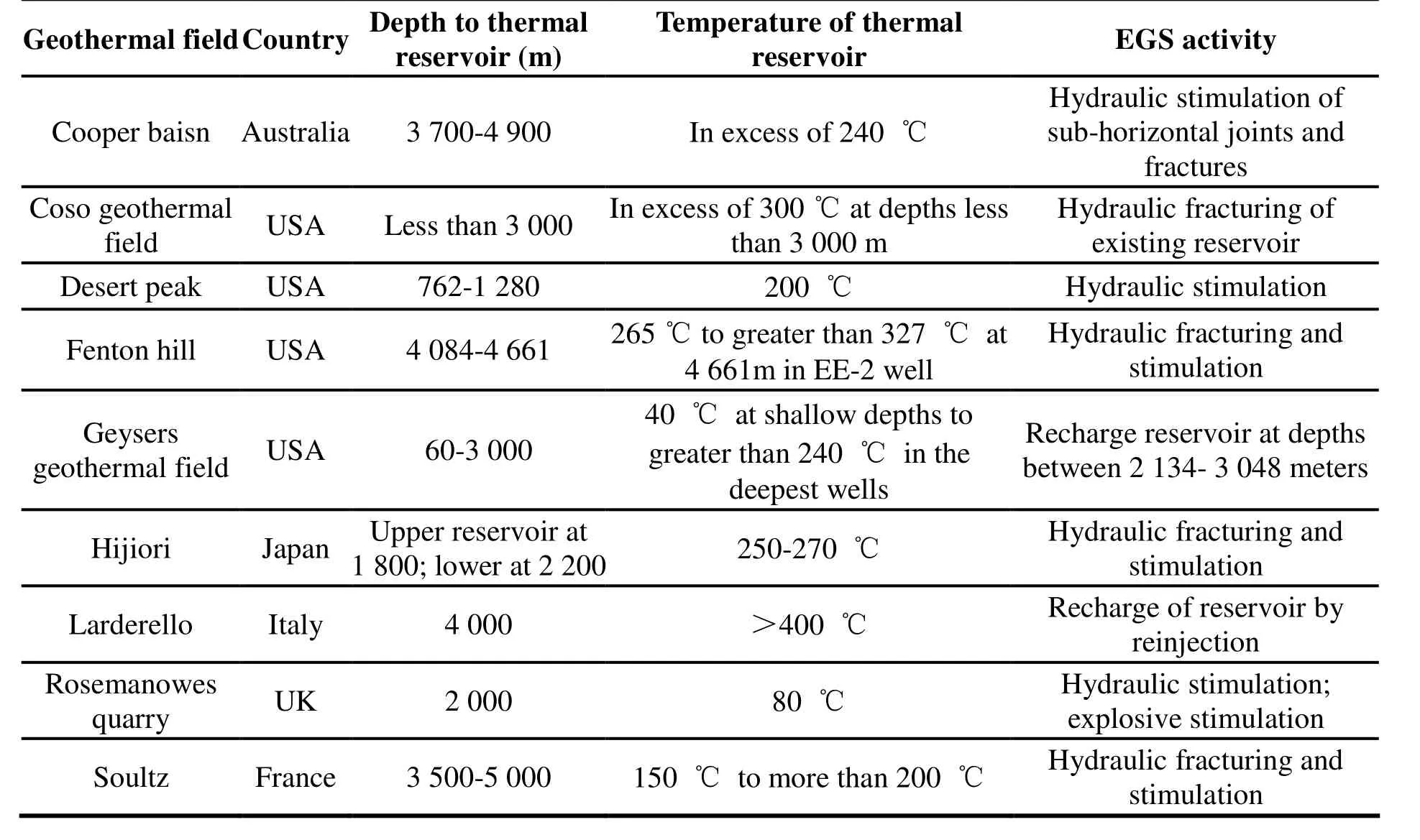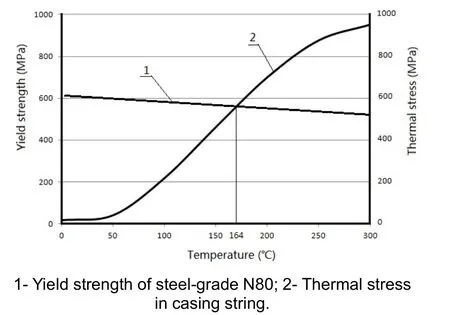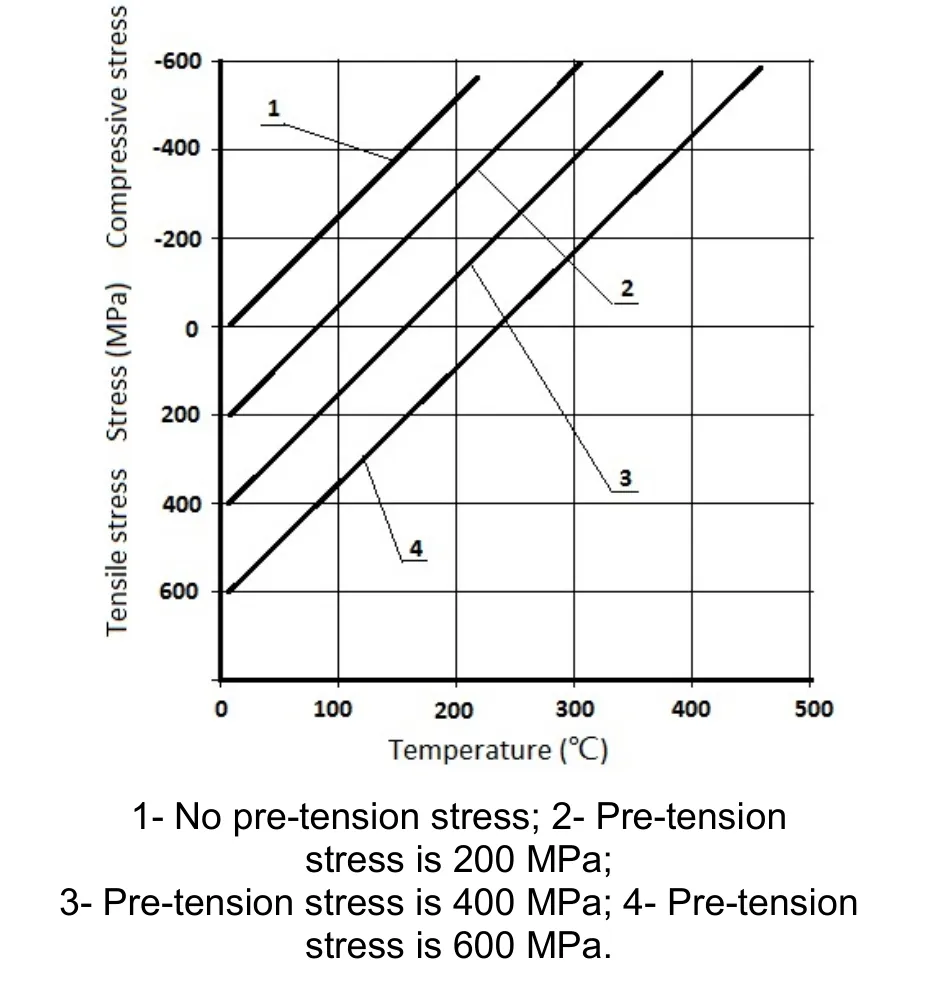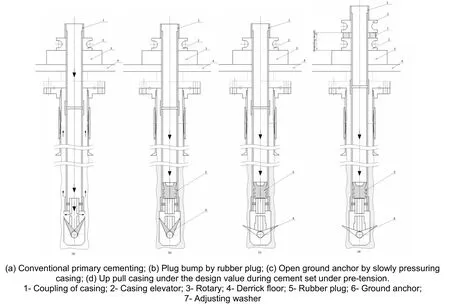Thermal stresses analysis of casing string used in enhanced geothermal systems wells
2016-11-25ZHANGPeifeng
ZHANG Pei-feng
Beijing Institute of Exploration Engineering, Beijing 100083, China.
Abstract: In the enhanced geothermal systems wells, casing temperature variation produces casing thermal stresses, resulting in casing uplift or bucking. When the induced thermal stresses exceed casing material’s yield strength, the casing deforms and collapses. The traditional casing design standard only considers the influence of temperature variation on casing material’s yield strength. Actually, for commonly used grades of steel pipe, casing’s material properties-such as yield strength, coefficient of thermal expansion, and modulus of elasticity change with temperature variation. In this paper, the modified thermal stress equation is given. Examples show that the allowable temperature of the material grade N80’s casing is only 164 ℃, which is much lower than that of the traditional design standard. The effective method to improve the casing pipe’s allowable temperature is pre-stressed cementing technology. Pre-stressed cementing includes pre-tension stress cementing and pre-pressure stress cementing. This paper focuses on the design method of full casing pre-tension stress cementing and the ground anchor full casing string pre-tension cementing construction process.
Keywords: Casing thermal stress; EGS wells; Casing deformation and collapse; Pre-tension stress cementing; Well completion design; Pre-stressed cementing
Introduction
The widely renowned Massachusetts Institute of Technology study “The Future of Geothermal Energy-Impact of Enhanced Geothermal Systems(EGS) on the United Stated in the 21thCentury”(MIT, 2006) suggests that EGS will be the future of geothermal energy utilization. EGS is an umbrella term for various other denotations such as Hot Dry Rock, Hot Wet Rock, and Hot Fractured Rock. This article is guided by Chinese scholars who pay attention once again to the high temperature geothermal resources and hot dry rock resources. China Geological Survey studies show that the hot dry rock resources of mainland China at depth 3.0 to 10.0 km amounting to 2.52×1025J,equivalent to 8.6×1012t standard coal. The development and utilization of hot dry rock resources to improve China’s energy structure, and to ensure its energy security is of great strategic significance.
Similar to conventional geothermal drilling technology, drilling in EGS originated in the 1970s with the Los Alamos-led hot dry rock (HDR)project at Fenton Hill. Drilling efforts in EGS continued with the British project at Rosemanowes in the 1980s, and the Japanese geothermal reservoir projects at Hijiori and Ogachi in the 1990s. Research and development in EGS continues today with an EGS European Union project in Soultz, France, and an Australian venture in Cooper Basin (Levy S S, 2010).
The core piece of an EGS installation is the heat exchanger at depth. It is generally accepted that it must possess a number of properties in order to be technically feasible and economically viable.These refer to the total volume, the total heat exchange surface, the flow impedance, and the thermal as well as stress-field properties. The key properties are summarized in Table 1 (Garnish J,2002; Rybach L, 2010). Table 2 shows the summary details for a number of geothermal fields where EGS activities have been tested (Karner S L,2005; Levy S S, 2010).

Table 1 Required properties for an EGS reservoir (Garnish J, 2002; Rybach L, 2010)

Table 2 Summary details for geothermal fields identified as EGS site(Karner S L, 2005; Levy S S, 2010)
ZK4002, the early geothermal well in the northern part of Yangbajing geothermal field in Tibet, China, was drilled in 1993 at a depth of 2 006.8 m. The bottom-hole temperature in ZK4002 was 329.8 ℃. The maximum temperature of wellhead was 204 ℃. The maximum working pressure of wellhead was 16 kg/cm2. It was regrettable that long-term continuous and steady fluid was not obtained because hydraulic fracturing was not experimented in ZK4002 well. And an injection well was not drilled either. As a result, an acceptable flow connection was not established between the two wells. The northern part of Yangbajing geothermal field is likely to be a potential EGS project area (it is considered as Hot Wet Rock or Hot Fractured Rock).
As a result of field experience at conventional high temperature hydrothermal and EGS sites,drilling technology has matured during the past 40 years. In particular, the experience at these abovementioned sites has significantly improved EGS drilling technology. Although the EGS drilling technology is developed from the oil and gas drilling,the EGS wells expose drilling fluid, casing pipe and downhole equipment to higher temperature than temperature common in oil and gas drilling. So, with the EGS well development,drilling high temperature wells has also become a requirement.
Thermal expansion can cause casing bucking and casing collapse. Also, thermal contraction due to cooling in injection wells, or thermal cycling in general, can also lead to casing damage and its eventual tensile failure. Current industry design standards consider the casing string to be statically loaded, yet it can be subject to variable loads due to changes in temperature or internal pressure during geothermal operations. As the movement of the casing is restricted by the presence of a cement sheath, temperature variations induce thermal stresses in the casing string, which may exceed casing material’s yield strength. In addition, the high pressure would be imposed on EGS wells because of hydraulic fracturing operations. So, the casing string of EGS is subjected to variable tension/compression loads. It is true that despite the continuous casing design improvements, there still remain unknown factors related to casing fatigue and integrity that could potentially cause problems in long-term production operations.
1 Influence of temperature on casings’material properties
An EGS well is subjected to cooling and heating sequences during its life. The thermal expansion of the casing occurs when hot fluids start flowing up the well. It has long been known that repeated cooling of the wellbore for logging or other remedial activities causes well integrity problems. Cyclic cooling and heating exposes the casing string to cyclic tension-compression loading.
In order to determine the influence of temperature on casing, the following assumptions were usually made:
● The casing cannot move in the cement sheath,
● There are no radial constraints as they would increase the average stress,
● The induced average stresses remain in the elastic domain, but the local stress values are in the plastic domain.
● The induced thermal stresses () are customarily given by

Table 3 Temperature at which the induced stress is equal to the yield strength of the material(Teodoriu C and Falcone G, 2009)
Table 3 shows the temperature variation that induces thermal stresses equal to material yield strength for commonly used grades of casing pipe.The values presented in the table were calculated using Eq. (1) and the following values for steel expansion coefficient (α) and steel modulus of elasticity (E): λ=12.5×10-6℃-1, E=2.05×105MPa.The table shows that the temperatures in any higher enthalpy geothermal well will cause plastic deformation even in casing strings made of high-grade steel.
Eq. (1) shows that temperature variation may exist and therefore the casing string is subjected to variable tension/compression loads. Usually, with the increase of temperature, the increasing gradient of casing thermal stress is 2.56 MPa/℃. However,the effect of temperature on the properties of the material was not considered. Actually, the material properties of casing for commonly used grades of steel pipe such as the yield strength, tensile strength, coefficient of thermal expansion, and modulus of elasticity change with temperature variation. Thus, it is unreasonable to use Eq. (1) to determine the thermal stresses of casing string.
The following casing grades have been commonly used in EGS application: J55, usually replaced by K55 for deep application; N80, usually replaced by L80 in the presence of H2S; C95,which has recently been replaced by T95; and P-110. Among these, N80 steel-grade pipe is most commonly used as casing strings in EGS wells.The calculation model of casing’s thermal stress under different temperatures would be established in this paper on N80 grade casing string.
LIU Xiao-gang et al. (2011) discovered that the yield strength, coefficient of thermal expansion,and modulus of elasticity of N80 change with temperature variation. This conclusion can be drawn using the following equation:

Eq.(2) shows that with the increase of temperature, the reduced gradient of the yield strength of N80 is 0.215 MPa/℃. Eq.(4) shows that between 50 to 250 ℃, the coefficient of thermal expansion substantially increases with the change of temperature.
Table 4 shows the variety of the physical properties in steel-grade N80 under the differential temperature. The values presented in table 4 are calculated using Eqs. (2) to (4). Table 4 shows that,under elevated temperature, casing grade N80’s yield strength and its modulus of elasticity is reduced progressively with a status of linear relationship. It is also important to note that, N80’s coefficient of thermal expansion is observably enlarged along with the temperature raising.

Table 4 Physical properties of steel-grade N80 under differential temperature
2 Axial thermal stresses in casings
In order to determine the influence of temperature variation on casing axial thermal stresses, the following assumptions are made besides the above assumption:
● Casing is seated in vertical well, and casing mediating extent is 100%.
● Cement bonds at first interface (bond face between casing and cement sheath) and second interface have not channeling.
● The expansion length of cement is negligible.
● Initial temperature of casing is equal to the temperature of the formation at the same depth; the highest temperature of casing is equal to the fluid temperature.
● The coupling of casing pipes is neglected.
Considering the effect of temperature variation on the material properties of casing, Eq.(1),thermal load of casing string can be rewritten as

Eq. (3) and (4) into Eq. (5), thermal stress in casing string at temperature variation ΔT can be get. Through calculation, we can see when the temperature is increased from 20 ℃ to 150 ℃ and 200 ℃ respectively, casing thermal stress increases to 462 MPa and 700 MPa accordingly, or the temperature variation that induces thermal stresses equal to material yield strength for casing grade N80 is only 164 ℃ (Fig. 1) which is much less than 222 ℃ showed in Table 3. Fig.1 shows the yield strength curve of casing material and thermal stress in the casing string with the change of temperature.

Fig. 1 Curve of yield strength and thermal stress of casing with temperature variation
According to Eq.(1), with the increase of temperature, the increasing gradient of casing thermal stress is 2.56 MPa/℃. However, according to Eq.(5), between 50 to 250 ℃, the increasing gradient of casing thermal stress is 4.19 MPa/℃. It is because the coefficient of thermal expansion substantially increases with the change of temperature.
It is customary in Yangbajing to drill high temperature geothermal so as to provide complete cement sheath from the shoe to surface on all casing strings, and the casing pipe is welded with the conductor pipe at wellhead. Although, this provides support and stability to the casing during thermal expansion as the well heats up during production, the high temperature geothermal wells because of casing repeated high temperature thermal expansion and occurrence of casing deformation and leakage etc. It is not reliable to only rely on all casing strings cementing to protect the casing from deformation or damage. So, in the casing design, it is very important that the effect of temperature variation on elastic modulus and thermal expansion coefficient of casing material should be considered.
3 Pre-stress cementing technology
In the early stage of developing high temperature geothermal field, the casing deformation or uplift, even fatigue was discovered after the rapid blowout or production well was put into use. It is because the thermal stresses in casing string exceed the yield strength of its material. How to prevent casing deformation and uplift has been the problem not only for high temperature geothermal wells, but also for EGS wells now. Previous major measures include the use of large diameter casing,cooling wellhead casing and the use of the quality and long-term behavior of the cement. Casing deformation or uplift and cement integrity are the key issues for high temperature geothermal wells since its desired lifetime is higher than that of oil and gas. Technologies conventionally used to protect the casing from fatigue for high temperature geothermal wells are inefficacious theoretically. So, Carden R S (1983) pointed out that despite the continuous casing design improvements, there still remain unknown factors related to casing fatigue and integrity that could potentially cause problems in long-term production operations.
With the development of heavy oil exploitation technology, pre-stress cementing technology has been developed and perfected gradually. The production of heavy oils usually requires the injection of steam, which is used to reduce the in situ oil viscosity, thus making the oil more mobile.Steam injection increases the temperature of the reservoir fluids to be produced. The main feature of these wells is the need for casing string pre-stress, which limits the effects of axial compressive forces due to thermal expansion. If the casing string is pre-tensioned, the total stress becomes an algebraic sum of thermally induced stresses and the existing pre-stress state in the casing.Fig. 2 shows stress changes of materials with temperature variation under different pre-stress.

Fig. 2 Stress changes of materials with temperature variation under different pre-stress
Pre-stressed cementing includes pre-tension cementing and pre-pressure cementing (Carden R S, 1983; LIU Kun-fang et al. 1994; Allen D M et al. 2000; YANG Xiu-juan et al. 2004; LI Zi-feng et al. 2008; ZHAI Ya-feng et al. 2010). Pre-tension cementing includes full casing pre-tension cementing and partial casing pre-tension cementing.Pre-pressure cementing includes steam preheating cementing and semi-preheating cementing.
The casing with pre-pressure cementing refers to exerting inner pressure on casing string and making casing expand in the cement solidifying period (LI Zi-feng et al. 2008). During the process of heat recovery, the casing temperature of EGS production well is increased. The casing operation conditions of the EGS wells accord with the steam preheating cementing. This technique will be an important method to prolong the casing life of the EGS wells. Compared with heavy oil thermal recovery wells in an oil field, there are less high temperature geothermal wells or EGS wells in a geothermal field, so it is difficult to bear the expensive construction costs such as heating and steam injection.
Partial casing pre-tension cementing is a stage cementing. The first use of conventional cementing method will be at the bottom sections of the casing cementing and the wellhead sections of the casing are free, waiting on cement until after a period of time, to casing some tension is applied, and then to the wellhead sections of the casing cementing. For example, Carden R S (1983) reported that the best option for their casing design was to cement the first 300 m prior to exposing the casing to a successive pre-tension. This method is simple and reliable, and it is worthy of development and application in EGS wells.
Full casing pre-tension cementing technique is to apply a certain tensile stress to the full casing string, and the casing string on the tensile stress state is solidification of cement slurry, after the completion of the cementing casing is subjected to tensile stress. When the temperature rises, this tensile stress should be the force to offset part of the casing thermal expansion pressure stress, so as to improve the casing temperature limit, and extend the casing lifetime (LIU Kun-fang et al. 1994; Allen D M et al. 2000; ZHAI Ya-feng et al. 2010).
To apply pre-tension stress, the bottom of casing string must be fixed firmly, and the casing in the wellhead must then be lifted to make the casing string produce the elongation. Ground anchor is a kind of tool used to secure the bottom of casing string. Research and development of ground anchor by Engineering and Technology Research Institute of PetroChina Liaohe Petroleum Exploitation Bureau is shown in Fig. 3.

Fig. 3 The construction process of ground anchor full casing pre-tension cementing (after Engineering and Technology Research Institute of PetroChina Liaohe Petroleum Exploitation Bureau, 2007)
4 Design and construction of pretension stress cementing
4.1 Pre-tension stress cementing design
The key of pre-tension cementing technology is how to determine the maximum temperature change area of casing. Heavy oil thermal recovery wells are through the heat-insulating tubing and downhole for steam injection, and the large temperature variations along the well in steam injection process is payzone production casing(YANG Xiu-juan et al. 2004; LI Zi-feng et al.2008). The casing program of high temperature geothermal well (and EGS production well) is different from heavy oil thermal recovery well(Teodoriu C and Falcone G, 2009). In the EGS production well, the largest temperature variation along the well is at wellhead, of course, according to well logging data. Casing pre-tension cementing design can be obtained through the following:
(1) Based on Eq.(3) and Eq.(4), calculating the elastic modulus and the thermal expansion coefficient of casing material at temperature T, and substituting it into Eq.(5) to obtain the thermal stress in casing.
(2) According to Eq.(2), the yield strength of the casing material at temperature T is obtained.
(3) The minimum pre-stress of casing (noted as) is different from thermal stress and yield strength. It can be rewritten as:


By the time I graduated from college, I was ready to spread my wings. I got a job teaching special education at a school in Coachella, California, a desert town about 170 miles from home. It was no dream job. Low-income housing across the street from the school was a haven3 for drug users. Street gangs hung around the school after dark. Many of my charges, emotionally disturbed 10-to 14-year-old boys, had been arrested for shoplifting, car theft or arson4.
For example, diameter of the production casing string in EGS well is 244 mm, thickness is 10.03 mm, casing grade N80, initial temperature 20 ℃, and maximum temperature 200 ℃. Based on the above calculation, the thermal induced stress of casing is greater than the yield strength of casing grade N80 at temperature 200 ℃, and the casing of wellhead is to be applied to the minimum pre-tension of 1028.16 kN.
4.2 Pre-tension stress cementing construction
Pre-tension stress cementing procedure for ground anchor full casing string is as follows:
(1) The ground anchor is connected with the lower end of the casing string, and together with the casing string down to the bottom of the well,conventional primary cementing.
(2) After the rubber plug is pressed, the rubber plug is seated on the upper part of the ground anchor, and then the slow pressure can be suppressed. When the pressure rises to 15 to 20 MPa,the anchor plug pin of ground anchor is cut off, the anchor rubber plug goes down, and pushes the central pipe and connecting rod to open the double level, and the double fluke of ground anchor is anchored into hole wall.
5 Conclusions and recommendations
(1) Temperature rise leads to casing thermal expansion, resulting in casing uplift, deformation and collapse in EGS wells. In the EGS wells completion design, the problems caused by the thermal expansion of casing should be paid enough attention to.
(2) Temperature rise not only causes the decrease of casing materials’ yield strength, but also leads to the change of casing materials’ elastic modulus and coefficient of thermal expansion.Casing materials’ modulus of elasticity decreases linearly with the rise of temperature, while its thermal expansion coefficient increases with the rise of temperature. So, in the casing strength design, it is necessary to consider the influence of temperature variation on the above parameters.
(3) Partial casing pre-tension cementing is a stage cementing. This method is simple and reliable, and worthy of development and application in EGS wells completion.
(4) Full casing pre-tension stress cementing is to apply a certain tensile stress on the full casing string, and the casing string on the tensile stress state is solidification of cement slurry. Due to the pre-tension stress exerted on the full casing string,the casing string has a certain pre-elongation and casing expansion caused by thermal stress can be reduced or offset. So, full casing pre-tension stress cementing can effectively prevent casing deforma-tion and damage and prolong casing lifetime.
Acknowledgements
This study is supported by the Hydrogeology Survey And Comprehensive Evaluation of Large Basin and Deep Typical Southeast Coastal Region(No. 12120114025101).
杂志排行
地下水科学与工程(英文版)的其它文章
- Building a scientific and ecological earth-on an important field of geo-science: Geo-environment and construction engineering effect
- A discussion of up-flow springs
- Statistical characteristics of heavy metals content in groundwater and their interrelationships in a certain antimony mine area
- Groundwater resources in karst area in Southern China and sustainable utilization pattern
- Study on engineering-hydrogeological problems of hydroelectric project
- Interactions between benzotriazole and corncob biochars pyrolyzed at different temperature
